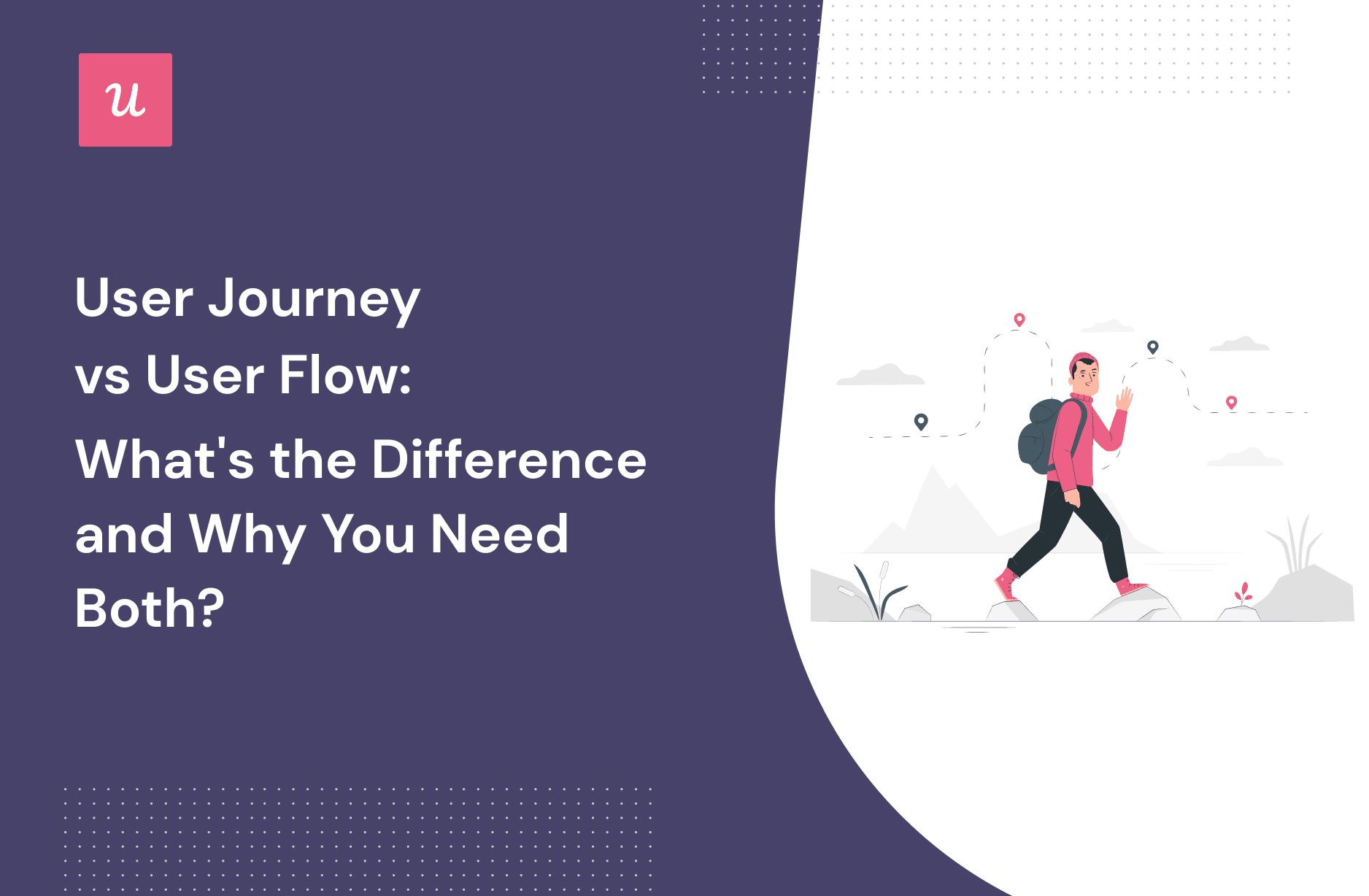
User Journey vs User Flow: What’s the Difference and Why You Need Both?
What’s the difference between user journey vs user flow? In UX design, there’s a lot of confusion about what these terms mean—even amongst experienced designers.
After all, they both describe a similar idea: a visual representation of a user’s actions when interacting with a product.
But despite their close relationship, they differ in several ways.
In this article, we’ll take a look at why you need both, the difference between them, and when to use each to improve your entire user experience.
Let’s get started.
Which concept gives you a “macro view” of a customer’s entire experience, including emotions and pain points over time?
Hint: Think about the big picture, from first awareness to long-term use.
If you need to map out the specific, step-by-step actions a user takes to complete a single task (like signing up), which would you create?
Hint: This is about the detailed path and removing friction from one specific process.
You’ve noticed a high drop-off rate during your trial activation. Which tool would be best to identify and fix the specific UI interactions causing friction?
Hint: To fix a leaky bucket, you first need to find the specific hole.
You’re ready to master both.
Understanding the user journey vs user flow is key to building better product experiences. Userpilot helps you analyze user behavior, identify friction points in your flows, and guide users through their entire journey—no code required.
Try Userpilot Now
See Why 1,000+ Teams Choose Userpilot

User journey vs user flow – quick summary
- User flow is a detailed representation of the path that shows the specific steps users take to complete a particular task.
- User flows focus on identifying friction points in the journey and removing them from the UI design, keeping users on a happy path.
- A happy path is the shortest path users can take to achieve their desired result without encountering any errors.
- User flows are used by designers to map out feature functionality and technical requirements when building products.
- The user journey is the representation of the overall experience a customer has while engaging with your product across their journey.
- With a journey map, product teams can carry out user research, improve user flow, and design a personalized product experience.
- Create a user journey map at the initial research phase of a project to understand user behavior and communicate the entire experience to stakeholders.
- The key difference between a user flow and a user journey is that a user journey gives a macro view of a customer experience, while a user flow gives a more zoomed-in view of the actions of a user.
- The key similarity between these two tools is that they’re user-centered.
- Want to build a better user experience without the stress of coding from scratch? Book a demo call with the Userpilot team and get started!
What is a user flow?
A user flow is a detailed illustration that shows the specific steps a user takes to complete a task using your product.
Think of it as a visual map of all the UI interactions the user has.
A user flow is visualized with flow charts, made up of boxes and arrows. Each box represents a step in a user’s action, like entering information or clicking a button.
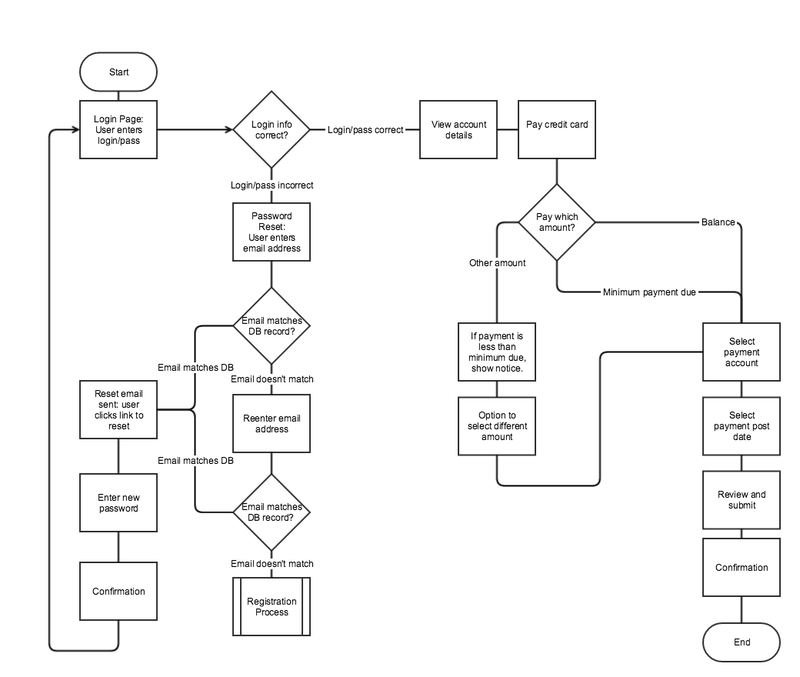
Example of a user flow
Let’s say we want to get users to create an account and complete their profiles. Here’s an example of what a signup flow might look like for a social media app:
- The user launches the app and lands on the signup screen
- The user clicks on signup to create a new account.
- At the point of registration, they provide information like email and password
- After the user creates an account, they’re asked to verify their email address
- When they’ve successfully verified their email, they’re redirected to the profile page to set up their account
- When this is completed, they save the changes and go to the home screen
The example stated above is known as a happy path. This simply means the path users take to achieve their desired result without encountering friction. In real life, however, things could go differently.
For instance, a user might take other alternative paths, like providing invalid credentials. These unhappy paths can be a gold mine when you’re looking into improving the user experience.
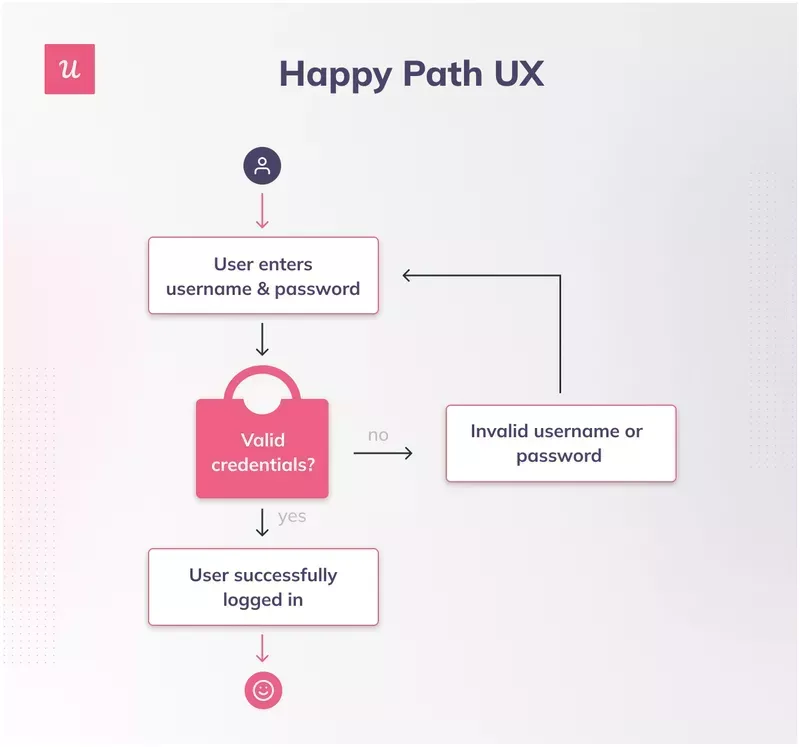
What’s the purpose of a user flow?
A user flow describes what a user sees on the screen and how they interact with the screen to move forward. This is critical for designing good product experiences, without getting lost in the details.
In summary, user flow should answer questions like:
- What should the user see first?
- How will they navigate between screens?
- What do users want to accomplish when they use this feature?
- What actions will users take at each stage of their journey?
It is also important to note that user flow is crucial for the development phase. Developers use this tool to translate designs into physical features.
Also, during a project, it’s possible to have several user flows.
So, every user flow diagram should have a name and a well-detailed description to communicate what each of the steps is and what it is accomplishing.
When should you use a user flow?
A user flow is used by designers to map out features and technical requirements. It can be used at any stage—before or during development—but it’s most effective when introduced in the early stages of the design process.
By understanding a user flow, you can analyze where a user drops off and debug the reasons before they become costly issues.
Did they encounter a bug? How can the flow be improved to reduce drop-off? Do we reduce the steps or the number of screens?
These are questions that can be answered by mapping the user flows.
What is a user journey in UX?
A user journey, also known as a customer journey, is the experience your customers have when interacting with your product at each touchpoint.
Think of it as the “story” of all the interactions and experiences between a user and your product, starting from the awareness stage to the activation point.
A user journey is a comprehensive tool.
Unlike user flows, it takes into consideration the overall customer experience, including the customer’s emotions, pain points, and expectations across various channels.
With a user journey, you can identify gaps in the customer’s experience and how you can improve.
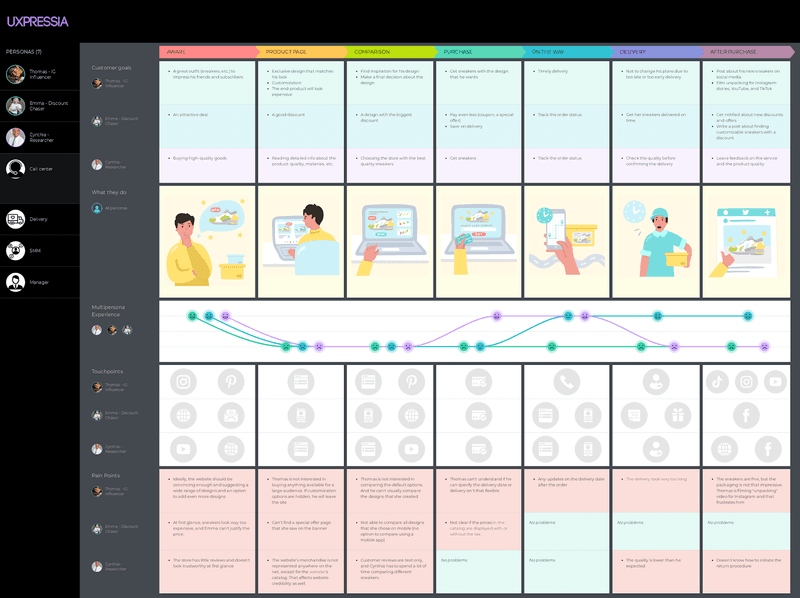
Example of a user journey
User journey maps can be built in different stages and for multiple user personas. For example, you can map:
- A day in the life journey to discover the activities of your users on a regular day- this helps you better understand them and how they interact with multiple products, not just yours. It also makes you more mindful when making decisions.
- The current state of your user and how the product and experience are so you can uncover friction points in their journey.
- The future state user journey map to predict what their experience will look like. This often involves assumptions.
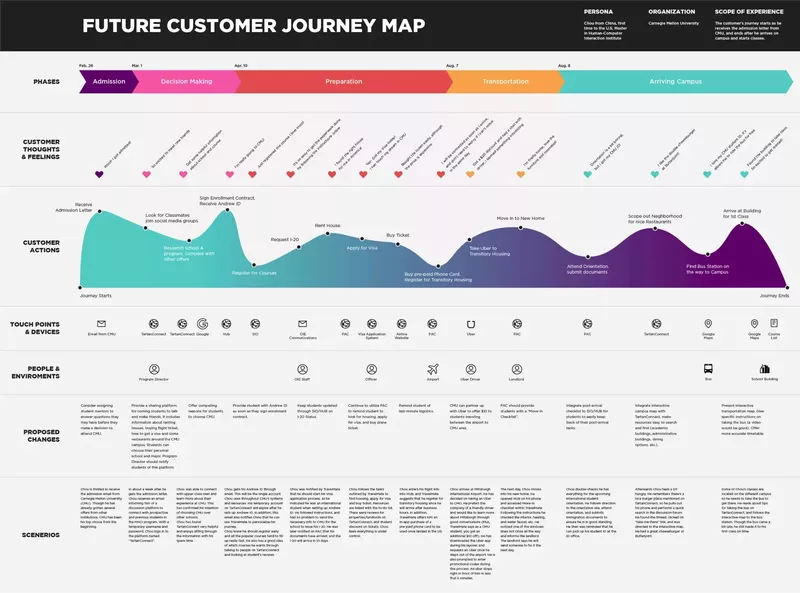
What’s the purpose of a user journey?
A user journey tracks users’ behavior when they’re interacting with your product.
A well-designed user journey map will give you insights into your personas’ minds to see what they’re thinking, feeling, and seeing at every point of interaction.
It also identifies possible friction points and potential areas for improvement.
With a journey map, product teams can carry out user research, improve user flow, and design a personalized product experience as well as a mobile experience.
The bottom line is, that without “seeing” the user’s journey, it’s hard to work on improving the overall product experience.
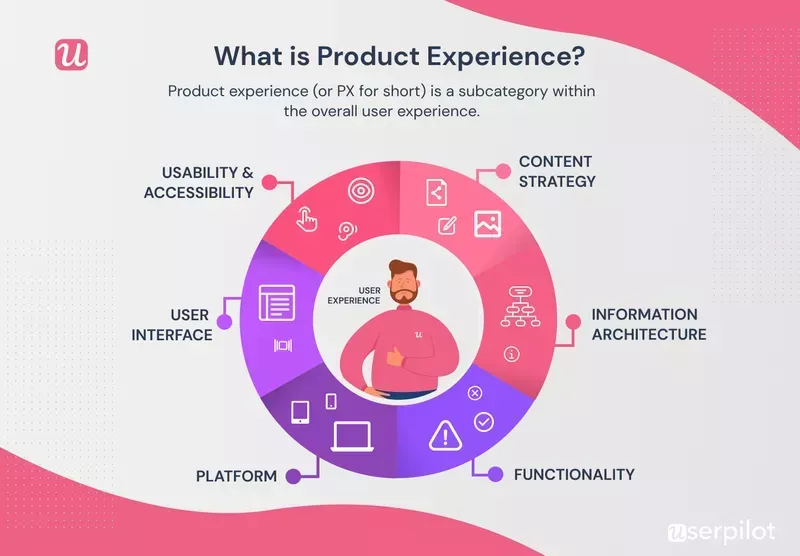
When should you use a user journey?
Customer journey maps should be created during the research phase of a project. Using this tool, project teams can capture a complete picture of the customer’s journey and see the product from the user’s point of view.
A journey map is also a great tool to walk stakeholders through the entire user journey, irrespective of their technical background.
In addition to this, customer journey maps also serve as a way to track user interactions and obtain feedback at every touchpoint that is valuable for product improvements.
With the collected feedback, it’s easy to prioritize the features important to the users.
What is the difference between user journey and user flow?
User journeys and user flows are two different types of user experience mapping. Although they both map out the path of a user, they do so in different ways.
The key difference between a user journey and a user flow is that a user journey focuses on the overall experience of an individual user, while a user flow focuses on each step in the design process. Here are other things that make them different:
- The number of users considered
A user flow concentrates on individual micro-interactions, while user journeys examine the macro-interactions of multiple user personas at once. Because of this, it’s often easier to create and maintain a user flow than a full-blown user journey map.
- The purpose
User journey helps you understand the overall experience of your customers at different touchpoints. User flow, on the other hand, outlines the process that each user takes to achieve their goal.
- The specificity of actions
User journeys are more generic. It gives you a bird’s-eye view of customer behavior across different platforms (mobile apps, web apps, etc.). In contrast, user flows are a lot more detailed and centered around one interface, e.g. web apps, capturing one step at a time.
- The key focus
A user journey is experience-focused; it deals with the users’ experience at each stage of interaction. User flow is action-focused; it concentrates on the details of the actions a user takes.
- Time range measured
User flow details the steps taken at a specific time, whereas a user journey map concentrates on the steps taken over time—from the awareness stage to when they actually buy from you.
What are the similarities between user flows vs user journeys?
Now that we’ve covered the differences between user flow vs user journey, it’s time to focus on what they have in common. Here are some similarities:
- They both have a common end goal—the user
- Both focus on creating the best user experience
- Both monitor how a user interacts with a product during its lifecycle
- Both tools are used for identifying users’ goals and pain points
- They can also be used as a communication tool for stakeholders and developers
- They give us insight into users’ needs and which features to prioritize
What comes first, user flow or user journey? Do you need both?
The short answer is neither.
Just like it’s hard to know if UI or UX comes first, it’s hard to tell if the user flow should come before the user journey. But here’s a better way to look at it.
The user interface (UI) is mapped using user flows. This means that the user flow determines what appears on the user’s screen at different times.
Meanwhile, the user experience is mapped using user journeys. They go hand-in-hand with each other.
Start by mapping the main stages of the user journey, then add experience details with user flow maps. Also, it’s important to note that user journeys are used to map the entire journey of a user or specific interactions for a more granular view.
For example, you can map a user’s journey from trial signup to the activation point.
This will help you to understand the main steps the users go through to convert. It will also reveal points of drop-off and why. That is why it’s best practice to create multiple flows that look at the UI steps the user takes.
Conclusion
Both user flow and user journey are great tools for creating an enhanced user experience. While user flows describe the specific steps a user takes to complete an action, the user journey considers the emotional response to each step.
Combining both tools creates a good user experience that increases customer satisfaction.
Want to build a better user experience without the stress of coding from scratch? Book a demo call with the Userpilot team and get started!






